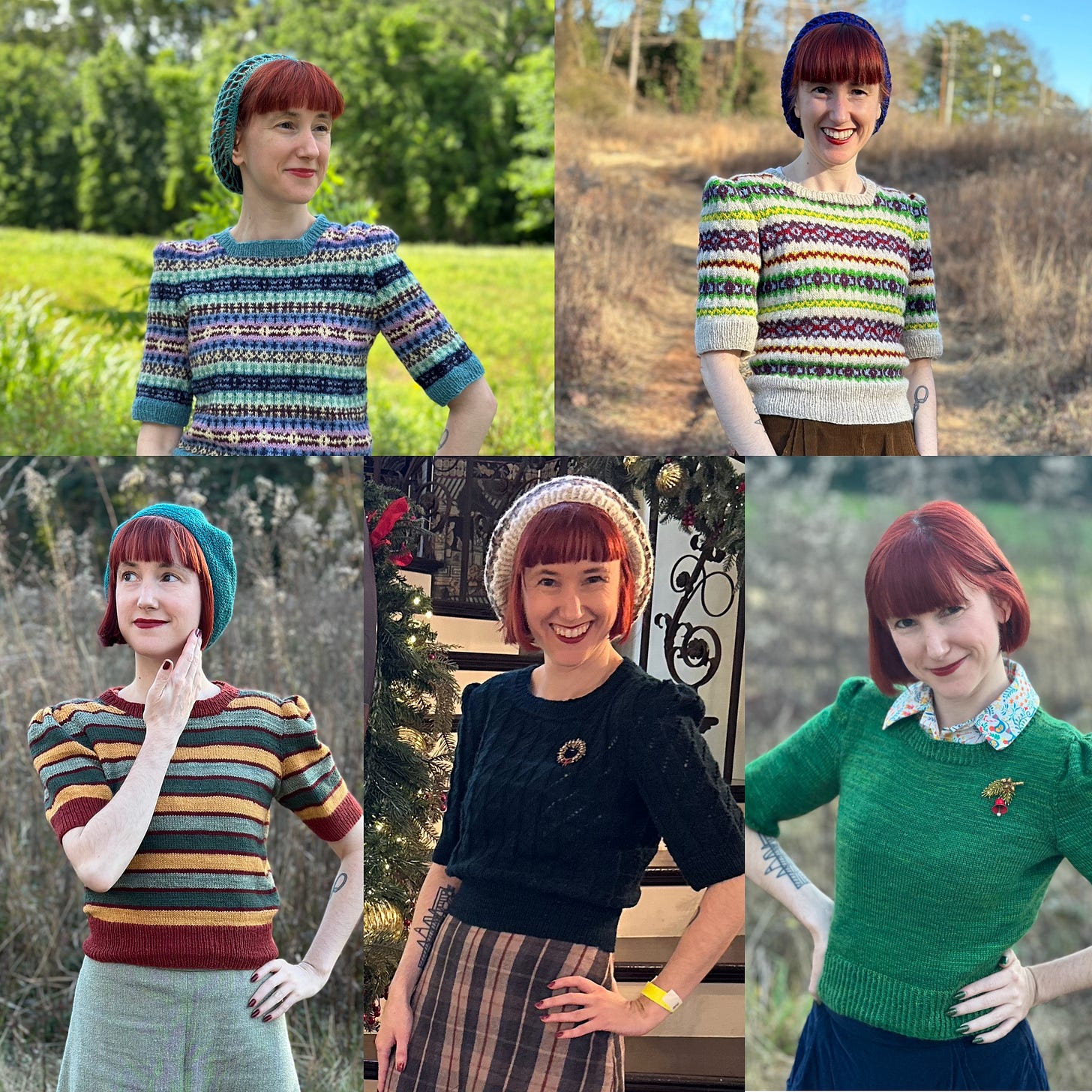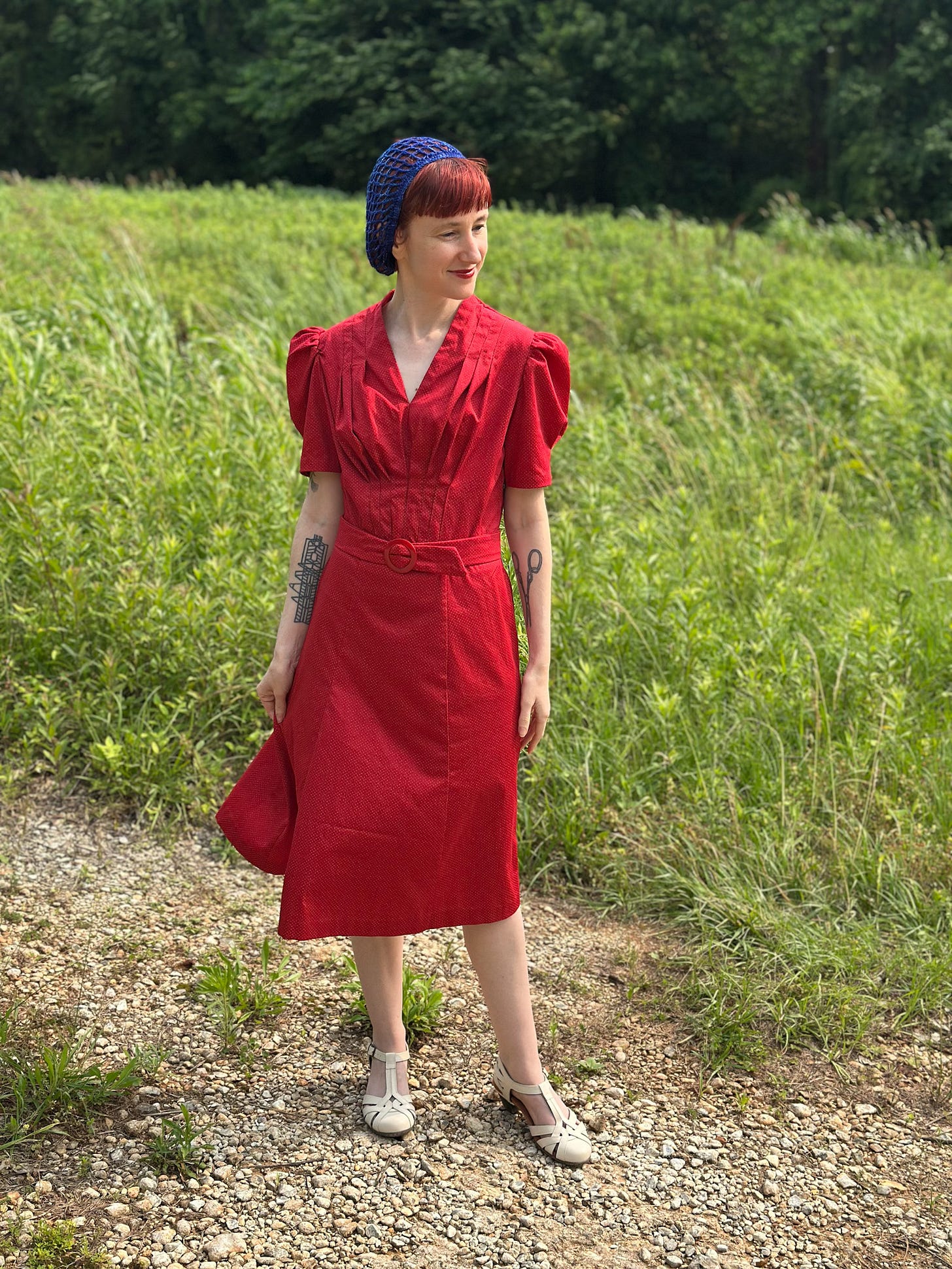HELLO DEARHEARTS!
I’ve started and not finished several posts over the last month— it’s hard to know what to say in this moment that might be helpful or useful, and also I confess that my interests have felt a little trivial. Who cares about clothes when there are More ImportantTM things to talk about?
I often talk about my obsession with making my own vintage wardrobe from a historian’s perspective. Working with true vintage patterns is a kind of light experimental archeology, allowing me to experience what home dressmakers in the past might have experienced and then to move through the world wearing the clothes they would have worn.
The truth is, my wardrobe is also deeply political.
I’m a leftist. One does not make it through a degree studying Latin American political history to come out the other end on the side of colonialism, imperialism, capitalism, or thinking the United States is ever the good guy. One then does not make it through a master’s degree in theology thinking that Christianity should ever be on the side of colonialism, imperialism, capitalism, or thinking that the United States is ever the good guy. I joke that I’m a manic pixie dream Marxist, which isn’t far from the truth.
When I learned how to knit and started making my own garments, I lost the taste for ready to wear clothes almost immediately. I’d already started favoring buying fewer, more expensive garments made by “ethical” brands (or at least brands cosplaying as ethical, cough cough Everlane), but old ‘90s mall kid habits die hard. I’d wander the aisles at Target wondering how on earth a sweater could ever cost $20.
Of course, I already knew the how. It was “by exploiting workers in other countries.” Knitting offered a glimpse of what it might be like to opt out of fast fashion, and, in turn, led me to learning how to sew my own garments. With these skills, I could no longer in good conscience participate in a system that was so detrimental to other humans (and the planet).
Garment sewing and knitting are my hobbies and I do both a lot. I’m not some paragon of minimalism and I do buy lots of fabric and yarn. There are plenty of folks who believe this makes me just as bad as Shein. Surely no one needs this many 1930s dresses when there are plenty of clothes on this planet already?
I find this kind of thinking reductive (and infuriating) because it neglects to consider how profoundly meaningful making something to wear is. In the face of the dehumanization caused by capitalism and fascism, reconnecting with our own human need to create, express ourselves, and be part of a community of makers has immense value. When I make my own garments, I’m doing my best to take human suffering (my constant swearing and stabbing myself with pins hardly counts) out of the process.
I basically quit clothes shopping in 2017, the same year I learned how to knit. I made my last new, ready to wear clothing purchases in 2021 (a couple of pairs of fancy cotton PJs and a linen skirt from a small ethical fashion brand, both right before I got into garment sewing). Since then, I’ve bought: a vintage pair of Scottish wool tweed plus fours, a Gap silk skirt from 2000 (replacing my favorite skirt from high school), two secondhand vintage wool blazers, and three vintage hats. (Shoes and undies not included!)
The hat and the plus fours in action! I made the sweater and blouse.
Buying clothes (even vintage) feels strange and unsatisfying to me. It’s odd to exchange money for a thing and have that be the end of it. It’s a cut and dry, one-off transaction, entirely different from making my own garments. The end result of having something to wear might be the same, but the difference in the process is staggering.
Every vintage garment I make starts with research. Since I’m favoring true vintage sewing patterns these days, I have to track them down. I’m SO grateful for the folks who do reprints of vintage patterns so I don’t have to worry about handling 80+ year old tissue patterns.
I’m less likely to work directly from a vintage knitting pattern. I love Susan Crawford and Squid School patterns. I use the Squid School Homefront Jumper (below) as a base for all of my 1940s jumpers—it’s SUPER versatile, knit to my measurements, and I’ve done the math to add steeks so I can knit all the colorwork I want in the round. I also have a custom base pattern for vests. Sometimes I reverse engineer patterns from photos, and sometimes I buy the true vintage pattern to have the reference for stitch patterns.
When I find the thing that is screaming at me, my next step is to dig into primary sources to get a sense of colors, fabrics, and styling (I’m extra partial to McCall’s Magazine), but Vintage Dancer also has some great photos and info. I’m not interested in high fashion of these eras—I want to wear what regular people would have worn on a daily basis.
I keep two documents with my schemes—one is a big list of everything I want to do with links to patterns and materials, and one is a more season-specific. It helps me narrow down my creative chaotic energy and hone in on what I can realistically get done. I never get to everything on the list and plans are always subject to change.
Once I’ve figured out my vision, I either stash dive or order what I need. I almost always make a full mockup for my vintage outfits, not so much for fit, but to figure out construction and seam finishes. Knitting almost always requires swatching and usually some light math. These practices make the process of actually making the thing more pleasant and are absolutely worth the time investment.
And then, of course, I actually make the thing. It can take me several days of more or less full-time sewing to make a vintage outfit, and I can knock out a sweater in a few weeks of concentrated knitting time.
By the time I wear the garment, I’ve spent countless hours of quality time with it. I’m deeply invested in it—financially, mentally, creatively, and even emotionally. I have every incentive to care for, enjoy, and mend my clothes, and also to repurpose them and rehome them as needed.
Along the way, I’ve also financially supported various small businesses (pattern sellers, fabric shops, yarn shops) and cut back as much as possible on the exploitation of garment workers. I’m the one hunched over the sewing machine and I do it for fun, not for poverty wages. I’ve connected with my community of other makers, too. It’s a nice middle finger to the constant churn of the fashion industry and the shitty messaging that ladytype people receive about aging, their bodies, and the male gaze. I dress purely for myself and am entirely uninterested in any trend post-1945.
I sometimes wonder if I’m trying to rationalize my goblin need to have “too many” clothes. But what drives me is not owning something, it’s making something myself. The whole is much greater than the sum of its parts.
There’s a reason that DIY is such an essential part of punk. It is absolutely revolutionary to make your own shit, to be an active part in creation and not a passive consumer of other people’s misery in order to profit the oppressor.
Plus, nothing says “I’m ready to punch Nazis” like strong 1940s shoulders.
xo,
Kathleen







If we have to punch Nazis again, we may as well look Nazi-punching era appropriate!
I often say that “existence is political” and, as you so-well demonstrate, fashion is part of that. Much of what I wear and make has witchy or goth-punk aesthetics because 1) I am a practicing witch and 2) that inherently makes me antithesis to the pervasive narrative of the person currently residing in the White House and his Project 2025 Christian Nationalist cult cronies. Proud to punch Nazis alongside you in our respective clothing (or hell, even without it, and REALLY piss off the patriarchy!).